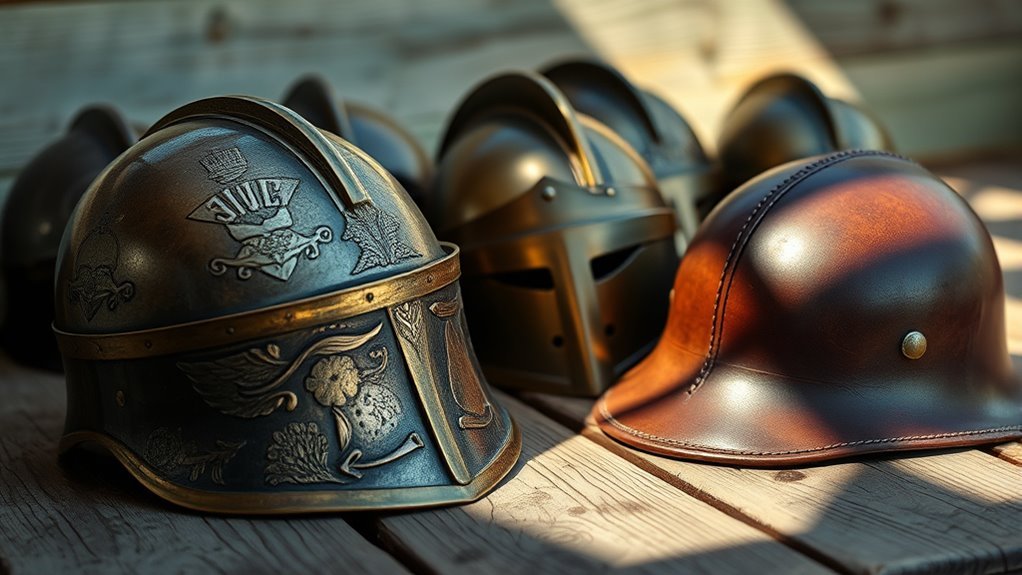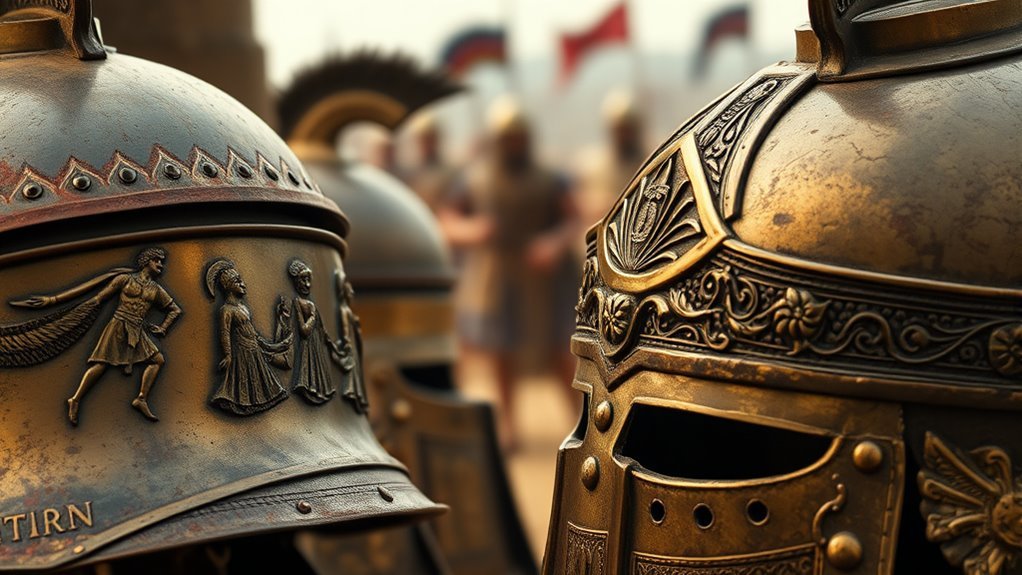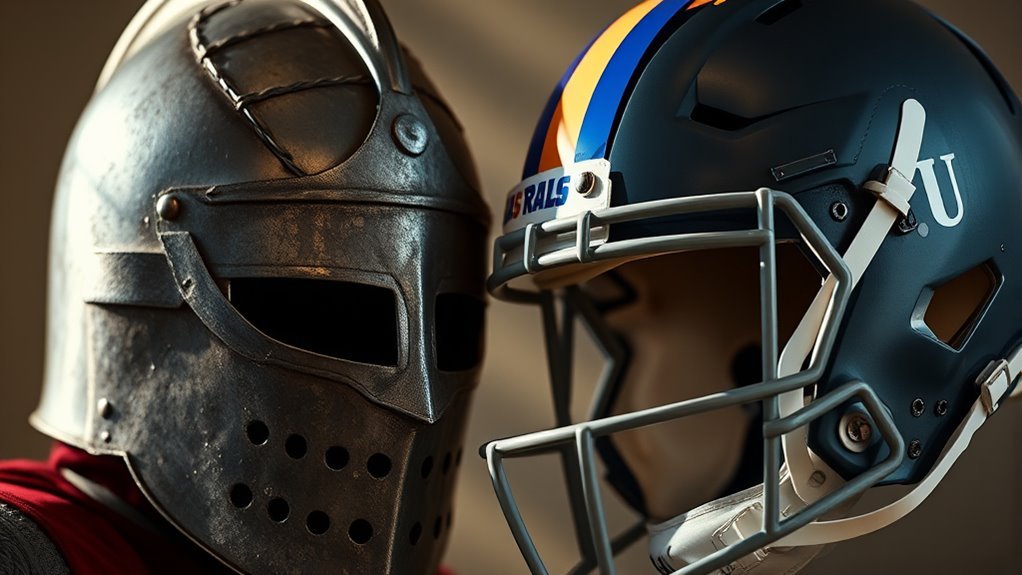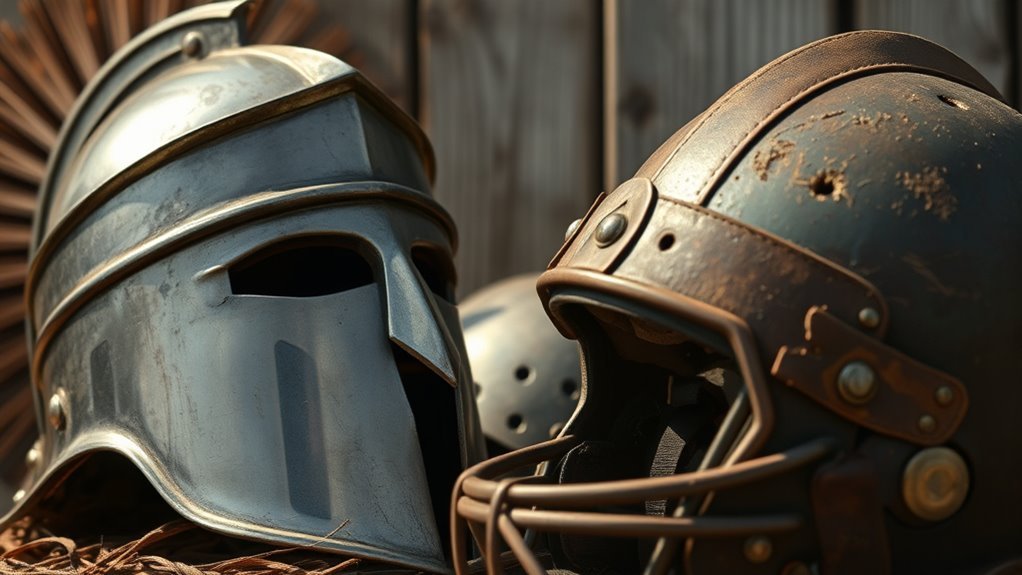The First Helmets: Origins in Military and Sports
The first helmets emerged from military armor, designed for protection in battle. They evolved from ornate Roman and Greek designs to simpler, effective versions like the Viking Nasal helmet. As society shifted towards sports, the need for head protection became essential in activities like boxing. Innovations in materials and technology introduced safer, sport-specific helmets. Understanding these changes reveals the significance of helmets today in safeguarding athletes. You’ll discover even more fascinating insights about this evolution.
The Evolution of Military Helmets

As warfare evolved, so did the need for protection, leading to significant advancements in military helmets. The Roman Gallic helmet, with its distinctive crest, offered both style and defense, symbolizing the might of its wearer. In contrast, the Spartan Corinthian helmet emphasized facial protection while enhancing visibility, embodying the warrior ethos of ancient Greece. The Greek Chalcidian helmet further refined this design, providing a balance of coverage and comfort. As we moved into the Medieval period, the Medieval Plate helmet emerged, showcasing intricate designs that reflected the social status of knights. Meanwhile, the Viking Nasal helmet became iconic for its simplicity and effectiveness, highlighting the adaptability of helmet designs in response to the changing dynamics of warfare and the relentless pursuit of freedom in battle.
Materials and Craftsmanship in Ancient Helmets

While the evolution of helmet design is often highlighted, the materials and craftsmanship behind ancient helmets reveal much about the technological and cultural contexts of their time. Ancient materials like bronze, iron, and leather were commonly used, with each choice reflecting available resources and the intended use of the helmet. Craftsmanship techniques varied, showcasing regional styles and skills passed through generations.
| Material | Craftsmanship Technique | Cultural Significance |
|---|---|---|
| Bronze | Casting and engraving | Status and protection |
| Iron | Forging and welding | Strength and durability |
| Leather | Stamping and lacing | Flexibility and comfort |
| Wood | Carving and binding | Lightweight defense |
| Composite | Layering and stitching | Innovation and adaptability |
These elements shaped not just functionality but also the identity of warriors.
The Transition From Warfare to Sports

Though warfare has historically driven the development of helmets, their evolution took an intriguing turn as societies shifted towards more peaceful pursuits, particularly in sports. As combat sports like boxing and wrestling gained popularity, the necessity for protective gear became apparent. Athletes sought not only to enhance performance but also to guarantee safety. This led to the establishment of helmet regulations that prioritized player welfare without compromising the spirit of competition. You’ve seen how these regulations adapted over time, reflecting a growing understanding of head injuries. This shift from military to athletic use illustrates a remarkable recontextualization of protective gear, emphasizing the value placed on safety in both life and sport, while maintaining the freedom to compete and innovate.
Early Sports Helmets: A Necessity for Safety
The shift towards organized sports inevitably highlighted the need for safety measures, particularly in contact sports where head injuries were prevalent. Early sports helmets emerged as a critical response to rising concerns about player safety. As player awareness of the risks grew, so did the demand for effective safety regulations. Helmets were designed not only to protect players but also to foster a culture of safety within the sports community. Innovations were rudimentary, often made from leather or other basic materials, yet they marked a turning point in how sports entities approached player protection. As the necessity for safety became clear, these early helmets laid the groundwork for future advancements, emphasizing the responsibility of leagues to prioritize player health and well-being.
Innovations in Helmet Design and Technology
As advancements in materials science and engineering emerged, helmet design underwent a significant transformation, revolutionizing safety in sports. You’ll find that techniques like 3D printing allow for intricate, lightweight structures, enabling helmets that better absorb impacts. Smart technology is also making waves, integrating sensors that monitor head trauma risk, providing vital real-time data. This innovation not only enhances safety but empowers athletes to make informed decisions. Additionally, aerodynamic design has become a priority, reducing drag and enhancing performance during high-speed activities. Coupled with custom fittings, these innovations guarantee that helmets conform to individual head shapes, maximizing comfort and protection. Ultimately, these advancements reflect a commitment to freedom—allowing athletes to push their limits while safeguarding their well-being.
The Role of Helmets in Modern Sports
In modern sports, helmets have evolved to prioritize athlete safety through innovative designs that absorb impact and reduce injury risk. Each sport’s specific requirements influence helmet features, from the padding used to the overall shape, ensuring peak performance while maintaining protection. By examining these advancements, you’ll see how they not only safeguard players but also enhance their capabilities on the field.
Safety Innovations in Helmets
While many might view helmets simply as protective gear, their evolution in modern sports reveals a complex interplay of technology, design, and safety standards. Today’s helmets are a culmination of design advancements aimed at enhancing helmet safety. Innovations like multi-layer padding, energy-absorbing materials, and improved ventilation systems drastically reduce the risk of concussions and other injuries. These advancements aren’t just about comfort; they’re about empowering athletes to perform at their best while minimizing risk. Additionally, rigorous testing protocols guarantee that each helmet meets stringent safety guidelines, offering you peace of mind. As sports continue to evolve, the focus on helmet safety will remain paramount, pushing manufacturers to innovate more and redefine what a helmet can achieve.
Sport-Specific Design Features
The evolution of helmet technology has led to sport-specific design features that cater to the unique demands of each athletic discipline. In sports like football, helmets incorporate padding and faceguards, addressing the impact of high-speed collisions while ensuring visibility. In contrast, cycling helmets prioritize aerodynamics and ventilation, reflecting the sport ergonomics necessary for prolonged endurance rides. Design adaptations also extend to materials, where lightweight composites enhance performance without sacrificing protection. Each feature is meticulously crafted to balance safety and comfort, allowing athletes to focus on their performance without distraction. As you engage in your sport, remember that these innovations are designed to enhance not just protection but also the freedom to perform at your best.
Impact on Athlete Performance
As advancements in helmet technology continue to reshape the landscape of modern sports, their impact on athlete performance becomes increasingly evident. Helmets designed with cutting-edge materials and engineering not only enhance athlete safety but also influence performance metrics. For instance, improved shock absorption reduces the risk of concussions, allowing athletes to focus more on their game rather than worrying about potential injuries. This sense of security translates into increased confidence and, ultimately, better on-field performance. In addition, specific features like ventilation and weight distribution can affect an athlete’s endurance and agility. By prioritizing safety through innovative helmet designs, you’re not just protecting athletes; you’re enabling them to reach their full potential and redefine the limits of their capabilities.
The Future of Helmet Safety Standards
Though advancements in materials and technology continue to shape the development of helmets, the future of helmet safety standards hinges on a collaborative approach among manufacturers, regulators, and consumers. You’ll notice that future regulations will likely prioritize transparency and adaptability, responding quickly to emerging research on head injuries. Safety advancements, such as impact-absorbing materials and enhanced ventilation systems, are essential, but they must be integrated into a framework that encourages innovation while ensuring user protection. As a consumer, your awareness and demands can influence manufacturers to prioritize safety without compromising performance. Together, we can drive a culture where helmet safety evolves, balancing the need for protection with the desire for freedom in sports and activities.
Frequently Asked Questions
What Are the Earliest Known Helmet Designs in History?
The earliest known helmet designs date back to ancient civilizations, where warriors crafted helmets from various materials like bronze, iron, and leather. These early helmets served as essential elements of ancient armor, often adorned with intricate designs to signify rank or tribe. The craftsmanship reflected the society’s values and technological advancements, demonstrating a blend of functionality and artistry. You’d find that these designs evolved over time, influenced by warfare and cultural shifts.
How Did Cultural Influences Affect Helmet Styles?
Cultural influences greatly shaped helmet styles, reflecting societal values and beliefs. You’ll notice that design evolution often incorporated cultural symbolism, like animal motifs or religious icons, which conveyed power or protection. For instance, warriors adorned helmets with symbols unique to their tribes, enhancing their identity. As cultures interacted, these designs merged, leading to innovative styles that showcased both functionality and artistry, allowing for a fascinating glimpse into the values of the societies that created them.
Who Were the First Manufacturers of Sports Helmets?
You might find it fascinating that the early manufacturers of sports helmets included companies like Riddell and Schutt. These pioneers took the concept of protection and turned it into an art form, focusing on helmet innovations that prioritized player safety while maintaining comfort. Their contributions not only laid the groundwork for modern designs but also revolutionized how we perceive sports safety gear. It’s incredible how their vision has shaped the landscape of athletic protection today.
How Did Helmet Regulations Evolve Over Time?
Helmet regulations evolved considerably over time due to increasing awareness of helmet safety and the need for player protection. Initially, rules were minimal, but as injuries became more prevalent, organizations began implementing standards. Historical evolution saw the introduction of testing protocols and certifications, ensuring helmets met safety criteria. You’ll notice that with advancements in technology, regulations have tightened, reflecting a commitment to safeguarding athletes while allowing for innovation and freedom in design.
What Are the Common Misconceptions About Helmet Safety?
You might believe that all helmets provide equal protection, but that’s one of the common helmet myths. Not all helmets meet the same safety standards, and some are designed for specific activities. Another misconception is that a helmet guarantees safety; while it reduces risk, it doesn’t eliminate it. It’s essential to choose a helmet suited for your activity and to replace it after a significant impact to guarantee maximum protection.






